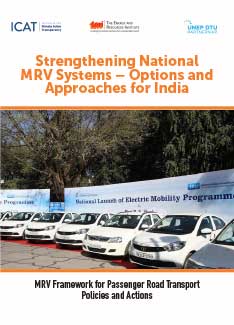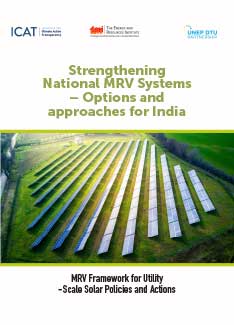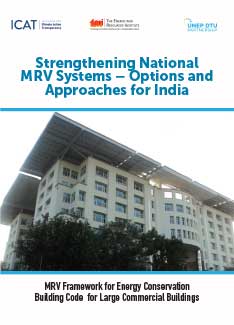Strengthening national MRV systems - Options and approaches for India
The countries adopted Paris Agreement and set an ambitious goal of keeping the increase in temperature well below 2°C. Almost all countries put forward their INDCs as a start towards meeting this goal. Further, the countries also agreed to undertake regular stocktaking to assess whether countries will be able to reach their commitment and to what extent are the efforts of countries enabling to keep the GHG emissions trajectory on track with the above-mentioned goal.

The Initiative for Climate Action Transparency (ICAT) aims to strengthen capacities in developing countries to assess the impacts of their climate policies and actions and to support greater transparency, effectiveness, ambition and trust in climate policies worldwide. The Initiative works with countries to build capacities on understanding and applying tools and approaches to measure, report and verify (MRV) greenhouse gas emissions reductions and adaptation action, as well as to strengthen existing institutional arrangements and processes for MRV of policies and actions.
A domestic transparency framework for India is needed to meet the requirements at international level and also to meet the needs at the domestic level. Internationally, it would help India to meet new international requirements as part of the Paris Agreement. Domestically, it will be helpful to track emissions, emission reductions and effectiveness of policy implementation. It will facilitate the creation of data management system, which is reliable, accurate and transparent. This is crucial for assessing the effectiveness of policy and providing feedback to overcome implementation gaps. Given the emphasis on transparency at international level, this might result in improved access to developed country support in terms of finance, technology and capacity building.
As per Biennial Update Report (BUR) of India, the monitoring and evaluation of government policies and programmes is an integral part of assessing the financial allocations. The monitoring includes both, financial and physical targets. In addition, systems exist for review of overall impacts at highest policymaking levels. Further, it states that national climate change programmes and other similar national programmes have a measuring and reporting systems, such as for energy efficiency, renewable energy, agriculture and forestry sector programmes and projects. However, these monitoring and evaluation systems do not conduct any MRV for GHG emissions and mitigation, though data collected under such systems could be used for GHG assessment. The second BUR highlights that "India is in process of establishing an integrated MRV system to track policy progress and impact on NDCs. Establishing an integrated domestic MRV system for GHG mitigation actions is a capacity building need for India."
TERI in partnership with UNEP DTU Partnership (UDP) undertook a research study with an objective to undertake an assessment of the existing monitoring and reporting systems, assess the gaps, develop appropriate options and approaches for MRV of mitigation policies and actions, specifically aimed at strengthening reporting on INDCs, as well as institutional arrangements for domestic MRV system.
As part of the project, the following reports (based on ICAT guidance and UNFCCC frameworks) highlighting MRV frameworks to assess the GHG impacts of key mitigation policies in renewable energy, transport and building sectors are now available:
- MRV Framework for Passenger Road Transport Policies and Actions
- MRV Framework for Utility-Scale Solar Policies and Actions
- MRV Framework for Energy Conservation Building Code for Large Commercial Buildings



